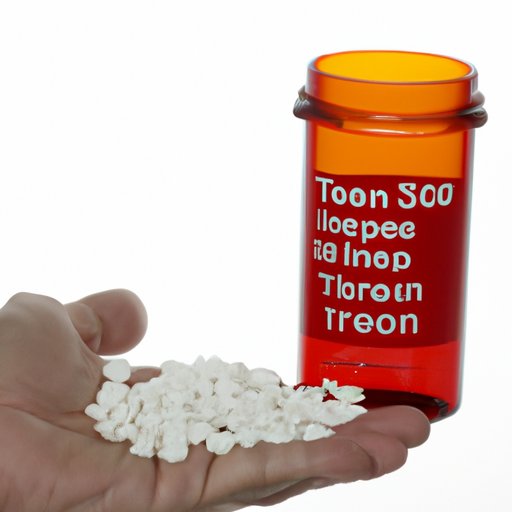Introduction
Acetaminophen is a popular over-the-counter pain reliever and fever reducer. It is the active ingredient in many common medications, including Tylenol and Excedrin. While it is generally safe and effective when taken as directed, acetaminophen carries a risk of serious health consequences when taken in large doses or with other medications.

Exploring the Dangers of Acetaminophen Overdose
For most people, taking the recommended dose of acetaminophen is relatively safe. However, taking more than the recommended dose can lead to a number of serious health problems. The most common risks associated with an acetaminophen overdose include liver damage, kidney damage, and even death.
Risk of Liver Damage
The most serious danger of an acetaminophen overdose is liver damage. According to a study published in the journal Expert Opinion on Drug Safety, “acute acetaminophen overdose is one of the most common causes of drug-induced liver failure worldwide.” In some cases, an overdose of acetaminophen can cause acute liver failure, which can be fatal if not treated promptly.
Risk of Kidney Damage
Another potential risk of an acetaminophen overdose is kidney damage. A study published in the journal Clinical Toxicology found that taking more than the recommended dose of acetaminophen can lead to renal tubular necrosis, a condition that can cause permanent kidney damage. In rare cases, it can be fatal.
Risk of Death
In extreme cases, an overdose of acetaminophen can be fatal. According to a study published in the journal Annals of Emergency Medicine, “there have been documented deaths from acetaminophen overdoses.” It is important to note that fatalities are very rare, but they do occur.
How Much Acetaminophen is Safe to Take?
The maximum daily dose of acetaminophen is 4,000 milligrams (mg). This is the equivalent of eight extra strength (500 mg) tablets. It is important to note that this is the maximum recommended dose for adults, and that children and elderly individuals should take less.
Different Forms of Acetaminophen
It is important to note that there are different forms of acetaminophen. For example, some combination products contain both acetaminophen and other ingredients, such as ibuprofen or codeine. In these cases, the total amount of acetaminophen should not exceed 4,000 mg per day.

What You Need to Know About Acetaminophen Safety Guidelines
When taking acetaminophen, it is important to follow the safety guidelines on the label. Here are some key points to keep in mind:
Understanding the Labels
The labels on acetaminophen products can be confusing. It is important to read the instructions carefully and understand how much acetaminophen you are taking. Some labels may list the amount of acetaminophen in each tablet or capsule. Others may list the total amount of acetaminophen in the entire package.
Avoiding Combination Products
As mentioned above, some products contain both acetaminophen and other ingredients. It is important to avoid these combination products, as the total amount of acetaminophen can add up quickly. If you need to take a combination product, make sure to read the label carefully and stay within the recommended dose.
Understanding Acetaminophen Dosage Recommendations
When taking acetaminophen, it is important to follow the dosage recommendations on the label. These recommendations vary depending on your age and weight. Here are some key points to keep in mind:
Age-Based Dosage
For adults and children over the age of 12, the recommended dose is 325-650 mg every four to six hours, not to exceed 4,000 mg per day. For children under the age of 12, the recommended dose is 10-15 mg per kg of body weight every four to six hours, not to exceed 75 mg per kg of body weight per day.
Weight-Based Dosage
For infants under the age of 2 months, the recommended dose is 10-15 mg per kg of body weight every four to six hours, not to exceed 75 mg per kg of body weight per day. For children between the ages of two months and 12 years, the recommended dose is 10-15 mg per kg of body weight every four to six hours, not to exceed 75 mg per kg of body weight per day.

Tips for Taking Acetaminophen Responsibly
To ensure that you are taking acetaminophen safely and responsibly, here are some helpful tips:
Follow Instructions Carefully
It is important to read the instructions on the label carefully and understand how much acetaminophen you are taking. Make sure to follow the dosage recommendations based on your age and weight.
Don’t Take More Than Recommended
Never take more than the recommended dose of acetaminophen. Doing so can increase your risk of side effects and serious health problems.
Don’t Mix with Other Medications
It is important to avoid taking acetaminophen with other medications, especially those containing ibuprofen or aspirin. Doing so can increase your risk of side effects and serious health problems.
Be Aware of Side Effects
If you experience any side effects while taking acetaminophen, such as nausea, vomiting, or abdominal pain, stop taking the medication and seek medical attention immediately.
The Risks of Taking Too Much Acetaminophen
Taking too much acetaminophen can lead to a number of serious health risks, including liver damage, kidney damage, and even death. It is important to follow the dosage recommendations on the label and never take more than the recommended dose.
Conclusion
Acetaminophen is a safe and effective pain reliever and fever reducer when taken as directed. However, it is important to follow the dosage recommendations on the label and never take more than the recommended dose, as this can lead to serious health risks, including liver damage, kidney damage, and even death. By following the safety guidelines and taking acetaminophen responsibly, you can reduce your risk of experiencing any adverse effects.
(Note: Is this article not meeting your expectations? Do you have knowledge or insights to share? Unlock new opportunities and expand your reach by joining our authors team. Click Registration to join us and share your expertise with our readers.)
